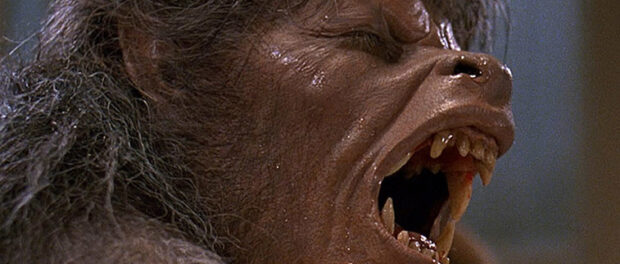An American Werewolf in London (1981)
[10]
With the success of Animal House and The Blues Brothers behind him, director John Landis was able to take a chance on a horror-comedy about two American college students who have a close encounter of the hirsute kind while backpacking through the English moors. David Naughton and Griffin Dunne star as the two Americans, Rick Baker provides the groundbreaking makeup and special effects, and An American Werewolf in London remains – 35 years later – the very best werewolf movie ever made.
In that early scene on the moors, Dunne’s character is brutally killed and Naughton’s is bitten — and we all know what that means, right? While Naughton falls in love with his nurse (Jenny Agutter), he’s haunted by the rapidly decaying corpse of his dead friend, who urges him to kill himself before the next full moon. Naughton resists, but when the full moon cometh, the beast within him emerges and the body count begins to rise. Now, if all that sounds dreadfully serious or terrifying, just remember this: The pub the boys stop at before their grisly confrontation is called ‘The Slaughtered Lamb.’
The comedy in An American Werewolf in London is pitch black, growing organically out of the story’s darkest moments. Take my favorite scene, for example, where the specters of Naughton’s victims share suicide tips with him in the back of a darkened porno theater. Another quintessential moment comes during the movie’s dramatic werewolf transformation scene. Naughton screams in agony as his body stretches and contorts, and at one point he looks up — maybe to the heavens? — maybe for help? — and sees nothing but a ridiculous Mickey Mouse figurine smiling back at him. I also love how Dunne’s character keeps popping up in various states of decomposition, his sarcastic sense of humor brilliantly undercutting his ghastly appearance.
Another thing I really love about Landis’ film (which he also wrote), is that it continues the narrative tradition set with 1941’s The Wolf Man and which was carried over through countless werewolf films between then and the release of Landis’ film in 1981. In all of those films, being a werewolf was a bad thing – a curse! Beginning in the ‘80s with the comedy Teen Wolf, and later with Mike Nichols’ bizarre entry Wolf, and most recently with the Twilight series of films, being a werewolf is more like having a superpower. And that doesn’t work for me.
What I’ve always found most intriguing about werewolf stories is the intrinsic male erection metaphor within them. Not having control over the effects of the full moon is similar to man’s inability to fully control penile erection. Erection, like werewolf transformation, calls a man out. It drags him down to his baser, more animal instincts. And while I can understand the sense of freedom or escape that might come with that lack of control (or giving into that lack of control), I’m much more empathetic to characters who don’t embrace chaos so freely. It is noble to fight the werewolf curse. Embracing the curse is akin to hiding behind biology as an excuse for bad behavior. So when it comes to werewolves and whether they are cursed or gifted with superpowers, we have to ask ourselves: Do we want our man to be the hero or the monster of the story?
Rick Baker earned the first-ever competitive Oscar for makeup (only special achievement awards were handed out prior to 1981). The transformation scene, achieved without computer generated imagery, is still the one by which all others are judged. We will probably never see a more horrifying werewolf transformation in our lifetimes. Credit must also be given to David Naughton’s fearless performance during that particular scene.
An American Werewolf in London can sometimes be an assault on the senses, especially when Landis indulges in surreal nightmare scenes involving Nazi zombies, or the wonderfully over-the-top car pileup at Piccadilly Circus. But it’s this mish-mash of elements that helps set the film apart. It goes to extremes in ways few other horror-comedies (or dark comedies) ever do, and it remains true to itself right down to its tragic ending and irreverent end titles.
It’s the stuff horror classics are made of.




